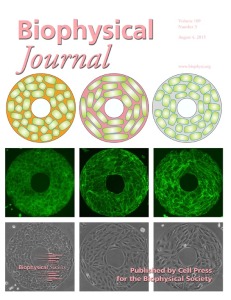 How did you compose this image?
How did you compose this image?
This image is intended to show how the rigidity of patterned substrate influences the collective arrangement and polarization of cells. Although it is thought that cell arrangement and polarization in pattern formation are regulated primarily by spatial gradients of chemical factors known as morphogens, this image and our article demonstrate that the mechanical factors also play crucial roles. The panels in the first and second rows are the phase contrast images and associated fluorescence images of actin, respectively, which were obtained from our experiment directly. The panels in the third row are schematic illustrations of cell polarization and alignment corresponding to the phase contrast images and the fluorescence images, which are produced by using CorelDraw software (http://www.coreldraw.com/).
How does this image reflect your scientific research?
The cover art image shows that cell polarization and alignment exhibit distinct features on the ring pattern of three different substrate stiffnesses, i.e., 60kPa gel, 40kPa gel, and 10kPa gel from right to left columns. Note that cells prefer to align along the direction of maximum principle stress, particularly on the pattern with highest and intermediate stiffness. Interestingly, these stiffness-dependent cell behaviors (alignment and polarization) exhibit a biphasic feature: Cells had less polarized morphology on both the softest and stiffest substrate, but adopted more polarized morphology on the one of intermediate stiffness. Meanwhile cells more preferentially aligned along the circumferential direction on the substrate of intermediate stiffness than on the ones of the highest and the lowest stiffness. Moreover, we found through mathematical modeling that these enigmatic biphasic behaviors were driven by the in-plane maximum shear stress in the cell layer.
Can you provide an example of how your research might lead to, or be used in, a real-world application?
Pattern formation is an indispensable requirement for the process of tissue morphogenesis. Understanding the mechanisms of pattern formation is crucial for tissue engineering, which allows people to control and regulate the growth of artificial tissue or organs. Our study may provide powerful tools for a precise control of the pattern formation in tissue engineering for potential biomedical applications.
Do you have a website where our readers can view your recent research? If you are interested in our research, please visit our website: http://www.biomechanics-bit.cn/English/Default.aspx.
- Shijie He, Chenglin Liu, Xiaojun Li, Shaopeng Ma, Bo Huo, Baohua Ji